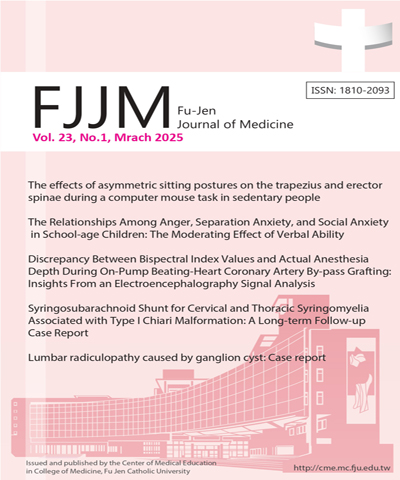
輔仁醫學期刊/Fu-Jen Journal of Medicine
輔仁大學醫學院,正常發行
選擇卷期
- 期刊
Background: Old obese subjects are particularly vulnerable to the complications of type 2 diabetes. Insulin resistance (IR), glucose effectiveness (GE), first and second phase insulin secretion (FPIS, SPIS) are recognized as the pathophysiological factors for inducing diabetes. In the study, we estimated IR, FPIS, SPIS and GE to determine which one contributes most for having glucose dysregulation in old female Chinese (prediabetes and diabetes). Materials and methods: We randomly enrolled 313 obese old women. The four factors were calculated by the equations published by our groups. The receiver operating characteristic (ROC) curve was used to calculate the area under the curve (AUC). Two models were built: Model 1: GE and FPIS and Model 2: Model 1 + SPIS. Results: The AUC of the four factors, from the highest to the lowest are SPIS, FPIS, GE and IR (0.722, 0.683, 0.681 and 0.534, respectively). The AUC of Model 1 (FPIS and GE) was 0.732 which is higher than that of SPIS. After adding the SPIS on to model 1, the AUC of model 2 does not increase (0.731). Based on this model 1, an equation was built (p = -331✕GE - 0.003✕FPIS + 5.45). If p is equal or higher than zero (≥ 0), the subject would have higher chance to have glucose dysregulation (sensitivity = 0.699, specificity = 0.636).
- 期刊
Background and Purpose: Asymmetric cup-to-disc ratio (CDR) has been known as one of the features of possible glaucoma. Optical coherence tomography angiography (OCT-A) enables non-invasive detection retinal microvasculature. This study aims to investigate characteristics of vessel density (VD) in subjects with asymmetric CDR. Materials and Methods: Subjects with asymmetric vertical CDR ≧0.2 without visual field deficit were recruited. Patients visiting for refraction checkup were enrolled in the normal group. All participants underwent comprehensive eye examinations and OCT-A scan. Results: Thirty subjects with asymmetric CDR and 30 normal individuals participated in this study. Eyes with larger CDR had lower peripapillary VD than normal eyes at whole image (48.13% vs. 50.05%; p = 0.007) and average peripapillary (51.58% vs. 53.27%; p = 0.030). Regional analysis showed that there was a reduction of VD in eyes with larger CDR than in normal eyes at nasosuperior (47.23% vs. 50.13%; p = 0.022), nasoinferior (45.66% vs. 48.63%; p = 0.015), and inferior sectors (49.68% vs. 52.63%; p = 0.026). Flow impairment was also detected at the superior quadrant of macula in eyes with larger CDR than in normal eyes (46.35% vs. 51.27%; p = 0.013). No difference in VD was found between two eyes of individuals with asymmetric CDR. Conclusions: Among subjects with asymmetric CDR, retinal microvasculature at the optic nerve head and at macula were similar in both eyes. Eyes with larger CDR showed reduction of peripapillary and superior quadrant of parafoveal VD in comparison with normal eyes.
- 期刊
Topiramate is a sulfa-derivative drug, which was used in many diseases, including seizure, migraine prophylaxis, trigeminal neuralgia, bipolar disorders, depression and weight-loss. Secondary acute angle closure glaucoma is one of the side effects of topiramate. We presented a case of 41-year-old myopic woman with acute bilateral blurred vision after taking topiramate as weight-loss drugs for ten days. Elevated intraocular pressure (IOP), increased lens thickness (LT), and decreased anterior chamber depth (ACD) were noted. After immediate discontinuation of topiramate and given ocular hypotensive medication, her IOP returned to normal and vision recovered completely. Review of the medication record is crucial, especially when acute angle closure and myopic shift occurred simultaneously.
- 期刊
Preeclampsia is a multisystem complication of pregnancy characterized by new-onset hypertension and proteinuria. We report the case of a 37-year-old primiparous woman with severe preeclampsia who developed bilateral SRD and pulmonary edema that required intubation and intensive care. After delivery, complete resorption of retinal serous detachment in both eyes was noted and visual acuity was restored in the left eye in six months follow- up. The preeclampsia pathogenesis results from systemic ischemia and choroidal arteriolar vasospasm. Secondary damage of the retinal pigmentary epithelium leads to fluid transudate and SRD. In this patient, preeclampsia-associated SRD spontaneously resolved within weeks of delivery.

